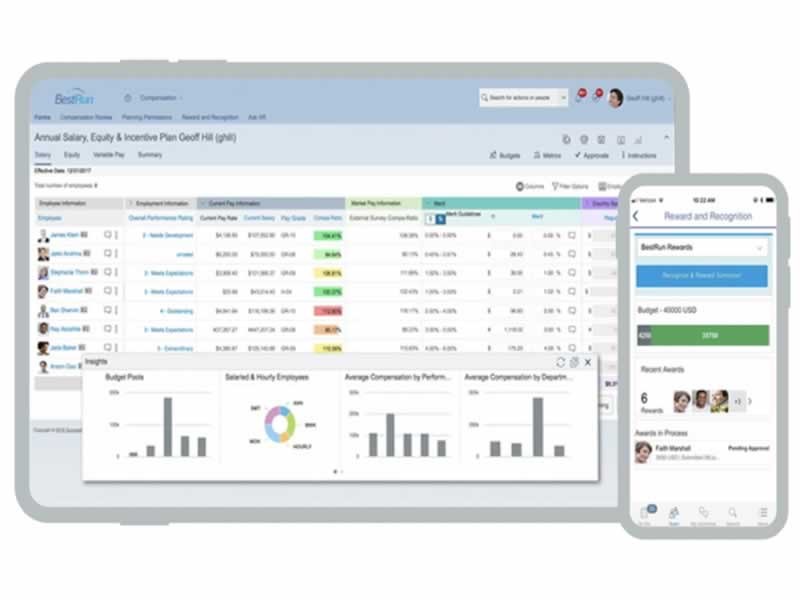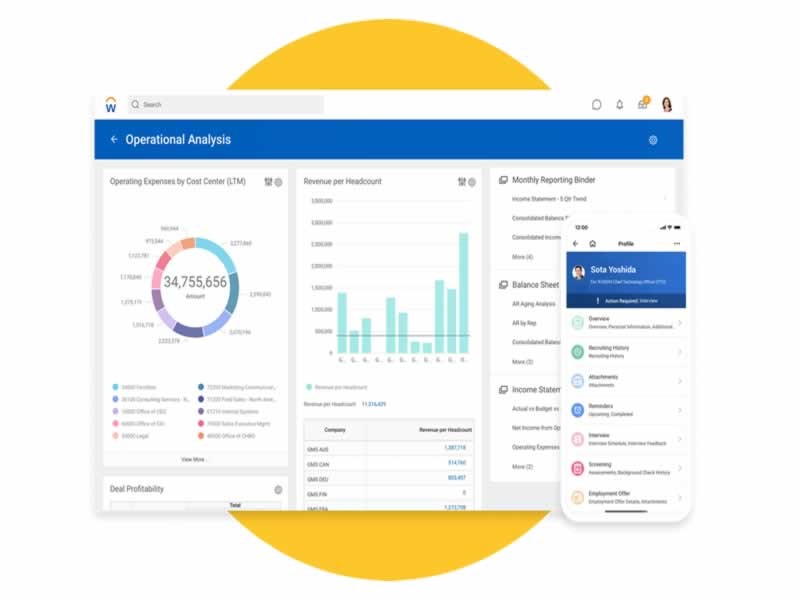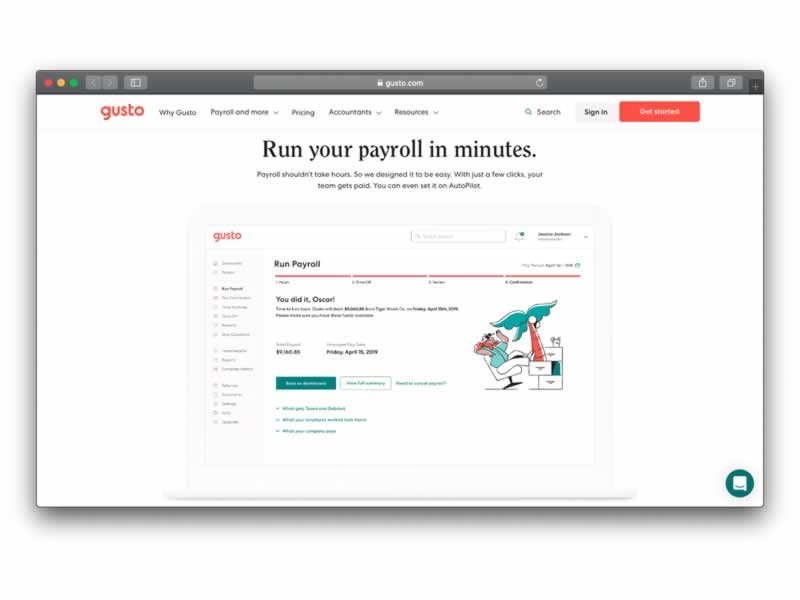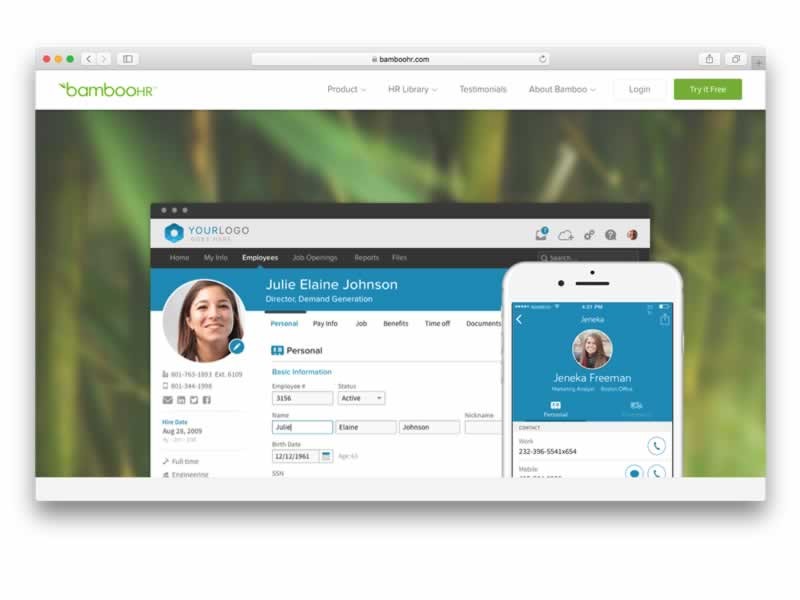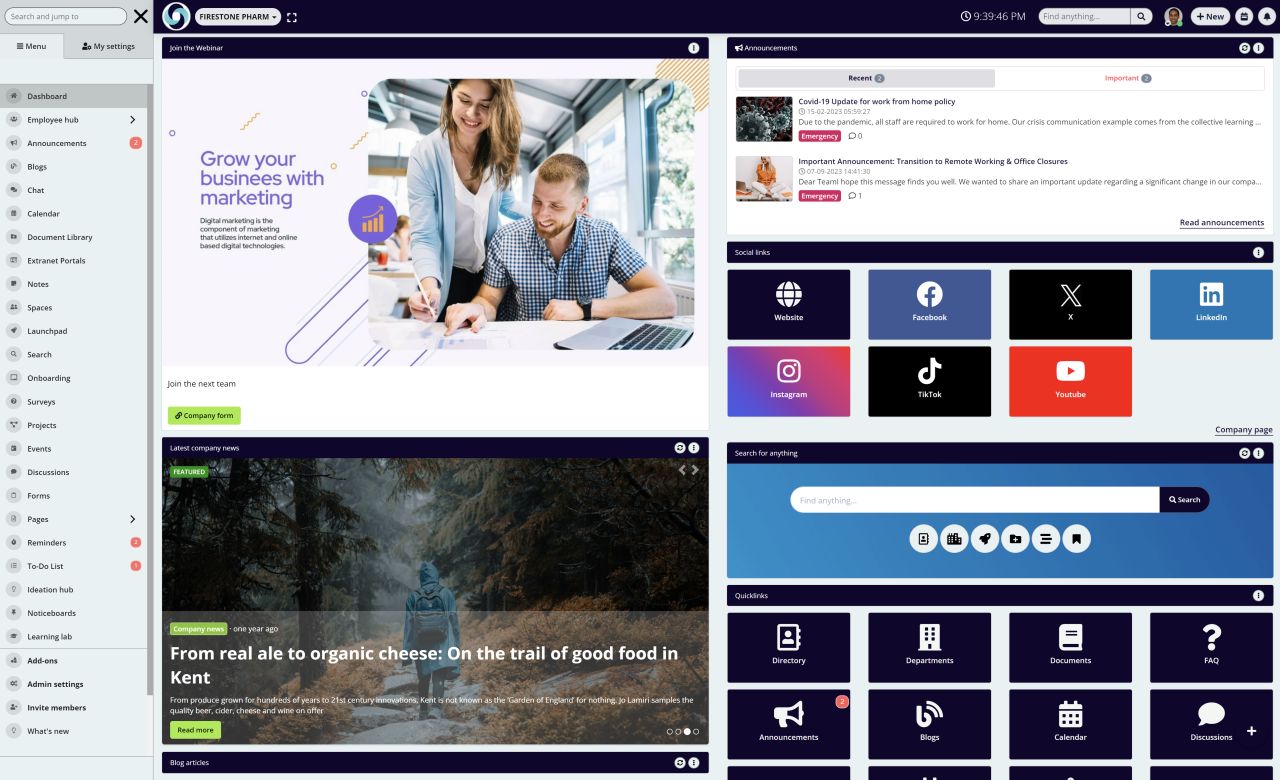Insight Blog
Agility’s perspectives on transforming the employee's experience throughout remote transformation using connected enterprise tools.
19 minutes reading time
(3831 words)
What are the Benefits of HRIS for Employees?
Embrace the future of human resources with a Human Resources Information System (HRIS), which offers a convenient solution for scheduling, payroll, and comprehensive employee management all in one place.
HRIS, or Human Resources Information Systems, offers numerous benefits for employees within an organization. In this article, we'll explore how HRIS enhances working conditions for workers and why companies should consider implementing this advanced system.
So, let's start by defining HRIS. According to TechTarget, HRIS is a platform that integrates technology, data management, and Human Resources to streamline HR-related tasks. It serves as a centralized hub for employee data, automates standard HR processes, and equips HR professionals with the tools to simplify their responsibilities.
Research from the HR Daily Advisor indicates that approximately half of respondents utilize an HRIS system, with about half opting for cloud-based or Software-as-a-service (SaaS) solutions. Notably, nearly 80% of HRIS users manage 100 or more employees.
For 28% of survey participants who use HRIS, logging in for more than half of the day is typical. The most prevalent uses among respondents include generating reports, managing payroll, tracking PTO/leave, and administering benefits.
A bit more on HRIS?
HRIS software, called Human Resources Management Systems (HRMS), effectively organizes a wide range of worker-related data points. These encompass sensitive personal details such as age, gender, and address alongside workplace specifics like job title, pay scale, and department. Also, HRIS manages information regarding employee benefits enrollment, timecard records and requests for time off.
In alignment with contemporary HR software trends, HRIS programs operate as browser-based Software as a Service (SaaS) solutions. They serve as comprehensive repositories, housing current and accurate data concerning a company's workforce.
While much of this data can be initially inputted during the employee onboarding process, the HRIS system must remain easily editable. This flexibility ensures swift updates or additions to employee records as necessary. Moreover, HRIS platforms empower HR professionals to generate detailed reports. These reports enable management to efficiently identify and address ongoing trends or patterns within the workforce.
Core Features Of An HRIS
HRIS systems encompass a diverse array of options, ranging from simple employee databases to complex multimillion-dollar Enterprise Resource Planning (ERP) suites, with various solutions in between. These systems offer a multitude of core functionalities, including:
- Benefits administration software for managing employee benefits effectively.
- Tools for payroll and compensation management, ensuring accurate and timely payment processing.
- Workflow, scheduling, or resource management tools to streamline organizational processes.
- Self-service portals empower employees to manage their information and tasks.
- Centralized databases for storing employee and organizational data, including organizational charts, handbooks, and best practices.
- Applicant tracking systems (ATS) to streamline recruitment processes and enhance candidate management.
- Performance management functions for tracking employee performance and aligning departmental efforts with strategic business goals.
- Workforce analytics capabilities for gaining insights into workforce trends and performance metrics.
- Despite the wide range of functionalities offered by HRIS systems, selecting the right HR software is crucial for maximizing their effectiveness. A well-chosen HRIS solution can significantly impact how efficiently and seamlessly these features are utilized, ultimately contributing to the organization's overall success.
HRIS vs HRMS vs HCM
The terms HRIS, HRMS, and HCM are often used interchangeably, but they each serve distinct purposes in the realm of human resources management. While they share some common ground in managing fundamental HR functions and employee data, they are not synonymous. Instead, they represent a progression in sophistication, catering to the evolving needs of businesses.
At its core, an HRIS provides essential data management and workflow automation capabilities. It serves as a foundational tool for streamlining HR processes.
Moving up the ladder, an HR Management System (HRMS) encompasses all the functionalities of an HRIS while expanding into areas such as recruiting, applicant tracking, onboarding, performance management, and employee engagement. It adds layers of functionality to support broader HR operations.
For instance, staff management software in the UK by SenseHR has advanced features like time management, performance tracking, on-boarding and employee self-service portals. These tools help businesses monitor employee productivity, streamline scheduling, and provide employees with easy access to their personal information and tasks. Such comprehensive solutions ensure that HR departments can operate more efficiently and strategically, enhancing overall workforce management.
Stepping further, a Human Capital Management (HCM) system encompasses everything offered by both HRIS and HRMS, with additional features geared towards enhancing the overall employee experience and aligning HR strategies with organizational goals. This includes comprehensive learning and development tools, compensation management, succession planning, access to industry data and benchmarks, advanced analytics capabilities, and business intelligence tools.
It's important to note that the specific features and functionalities may vary depending on the provider. The examples provided here offer a basic overview of what each type of HR software typically includes, but businesses should evaluate their unique needs and choose a solution that aligns with their requirements and goals.
HRIS examples
Here are Hris for employees examples in 2024:
- Workday
- SAP SuccessFactors
- Oracle HCM Cloud
- ADP Workforce Now
- BambooHR
- UltiPro
- Namely
- Kronos Workforce Ready
- Paycom
- Zenefits
Towards the end of ths aricle we will list 5 of the top HRIS cloud tools.
Types of Human Resource Information Systems (HRIS)
By considering the specific features and functions required from an HRIS, you can identify and select the most suitable type that aligns with your organizational needs.
#1.Operational HRIS
The operational HRIS category encompasses tools designed to aid HR personnel and managers in various talent management tasks such as recruitment, promotions, transfers, etc. These solutions aim to enhance the efficiency and effectiveness of existing HR systems.
An applicant tracking system (ATS) is a key component of operational HRIS. It manages all open positions within the organization and streamlines processes to expedite hiring. Its functionalities include:
- Posting job listings across multiple platforms.
- Screening applications to identify qualified candidates.
- Pinpointing bottlenecks in the recruitment pipeline.
Additionally, a performance management system is integral to this category, housing employee data related to performance evaluations. It supports employee retention, promotions, transfers, job rotations, and handling terminations when necessary. By providing insights into employee utilization and identifying areas where additional support may be needed, a performance management system enables managers to make informed decisions about talent management strategies.
#2.Strategic HRIS
Modules and functionalities within strategic HRIS systems facilitate analysis, decision-making, and goal-setting in human capital management. These solutions are tailored to assist companies with specialized hiring needs in finding and retaining talent.
Workforce planning tools aid HR teams in determining the necessary qualifications, skills, responsibilities, reporting structures, and salary considerations for specific roles. This capability assists in devising strategies to address skill and role gaps within the current workforce, influencing recruitment strategies and learning and development plans accordingly.
A learning management system (LMS) is crucial in succession planning, mainly when operational decisions involve job rotations or promotions. It tracks employees' skill sets across the organization and identifies individuals ready for additional training or certifications based on recent role or responsibility changes.
This facilitates proactive talent development efforts and ensures that employees are adequately prepared for evolving job requirements.
#3.Tactical HRIS
The tactical HRIS category focuses on enhancing efficiency and ensuring compliance in internal workforce management. Tools and functionalities within this category aid HR leaders in optimizing the utilization of existing resources for various functions such as compensation, recruitment, training, and benefits administration.
Tactical human resource modules gather external data concerning a business's competitors, industry trends, and regulatory requirements. HRIS systems not only streamline tasks but can significantly enhance strategic decision-making, productivity, and employee experience. Offering numerous benefits such as safeguarding confidential data and eliminating paper records, these systems are essential investments for modern businesses.Learn more about various benefits of implementing HRIS systems and how they can transform your organization.
Compensation and benefits management significantly impact employee satisfaction and represent substantial business expenses. As such, company leaders are keenly interested in regularly evaluating the organization's benefits package as part of overall employee compensation.
Suppose an HRIS indicates that a particular benefit is underutilized among employees. In that case, HR leaders may need to promote awareness of the benefit or consider reallocating resources to alternative benefits that better meet employee needs.
#4.All-Encompassing HRIS
A comprehensive HR information system acts as a centralized hub for storing all necessary data to facilitate nearly every HR management task. It functions as a single repository for a wide array of information that supports operational, strategic, and tactical HR functions collectively.
These three functions are interconnected and mutually influential. For instance, data detailing the role's position within the organizational hierarchy and its contribution to company objectives serves both operational and strategic purposes in job analysis and design.
For larger enterprises, employing a comprehensive HRIS is logical as it consolidates data from all three functional systems. This amalgamated information offers valuable insights, enabling HR and business leaders to make prompt, well-informed decisions. Conversely, businesses with specific tactical requirements that cannot be met by an all-in-one solution may find value in investing in a more limited-scope information system.
On the other hand, smaller businesses might prefer a simpler HRIS platform that caters solely to core HR management functions such as payroll. In such scenarios, implementing and maintaining a comprehensive HRIS could prove overwhelming. Moreover, the associated higher costs may render all-in-one HR suites financially unfeasible for many smaller businesses. Statistics indicate that approximately 68% of small businesses consider cost as the primary factor when choosing an HRIS solution.
#5.Specialized HRIS
Unlike comprehensive HRIS, specialized HRIS solutions focus on specific functions or a narrow set of HR tasks, such as payroll management or benefits administration.
Regardless of the specific HR functions targeted, an employee information system remains a fundamental component of HR software. This system gathers, stores, and tracks various personal and professional details of employees, including but not limited to their names, addresses, demographic information, educational backgrounds, employment history, and more.
Specialized HRIS platforms are often more cost-effective compared to comprehensive solutions, making them a viable option for small businesses with limited budgets. Moreover, these systems are typically designed to be user-friendly, allowing solo HR professionals to effectively manage them without extensive support.
For small companies with streamlined HR teams, specialized HRIS platforms offer a more manageable and focused approach to meeting their HR needs.
Why HRIS is important for your business?
HRIS plays a pivotal role across various management levels within organizations, aiding in the alignment of labor requirements with long-term business plans and strategic objectives.
Statistical data reveals that medium-sized management heavily relies on HR systems to oversee and analyze employee recruitment and compensation. Furthermore, operational management utilizes HR systems for efficient tracking and placement of employees.
The integration of human resource management and information technology within HRIS not only fosters competitive advantage but also garners significant attention from HR managers and professionals. Studies highlight several key benefits, including enhanced human resource decision-making, strengthened organizational character, and substantial reductions in process and administration costs.
Most importantly, HRIS expedites transaction processing, minimizes information errors, and enhances tracking and control of human resource actions, thereby playing a critical role in operational, controlling, and planning activities within the HR domain.
In essence, HRIS is a computerized system pivotal to information processing in human resource management, emerging as an indispensable element across all organizational sectors. Its multifaceted importance encompasses operational support for data collection, storage, and report preparation, streamlining processes, controlling data accessibility, cutting labor costs for HR departments, and furnishing timely and comprehensive information to management. Such data empowers quality strategic decision-making concerning human capital management within companies.
What are the benefits of an HRIS?
As your team expands and the necessity to manage sensitive employee information becomes increasingly evident, incorporating an HRIS into your company's infrastructure becomes paramount. Here are five key advantages of utilizing an HRIS:
Follow us and access great exclusive content everyday: Follow us on Google News
#1.Streamlined Organization
Before the emergence of cloud storage and rapid computing, HR tasks were burdened with laborious manual processes, reliant on physical documents and cumbersome filing systems. However, with the advent of modern technology, Human Resource Information Systems (HRIS) have revolutionized this approach by establishing a meticulously organized database.
This digital repository empowers administrators to swiftly access and retrieve employee data with just a few clicks, marking a significant reduction in the time and effort previously dedicated to manual tasks.
#2. Enhances Company Image with Employees
You might assume that non-HR employees will only perceive change once you integrate an HRIS, but that's a misconception. A proficient HRIS becomes readily apparent to new hires as it aids in talent acquisition and streamlines the onboarding process. Meanwhile, existing employees benefit from simplified time card management and vacation time requests through the system.
Adopting an HRIS demonstrates to your employees that you are committed to investing in their well-being and efficiency.
#3. Boosts HR Staff Efficiency
An HRIS package empowers HR professionals to work with enhanced efficiency by enabling quick filing, retrieval, and editing of employee information. Tasks that previously consumed minutes or hours can now be accomplished in seconds, from approving requests to validating timecards and processing payroll swiftly.
This efficiency is particularly advantageous in managing remote employees or hybrid staff arrangements, ensuring smooth operations and optimal utilization of resources.
#4. Ensures Regulatory Compliance
Adherence to local, state, and federal regulations is paramount for small business owners.
Whether it's compliance with the Health Insurance Portability and Accountability Act (HIPAA), the Worker Adjustment and Retraining Notification (WARN) Act, or other significant HR-related legislation, a reliable HRIS supports your team in maintaining the company's legal compliance and steering clear of costly penalties.
#5. Enables HR Professionals to Focus on Higher-Value Tasks
By alleviating the burden of mundane HR tasks, an HRIS liberates HR leaders to concentrate on more significant initiatives that can enhance the overall company performance. With the assistance of a robust HRIS, a competent HR department can promptly respond to employee trends and dedicate efforts to nurturing a company culture that boosts morale and improves employee retention rates.
#6. Enhancing the Strategic Vision for Company Development
HRIS empowers you and your team to make more strategic decisions. Centralizing data on personnel and their work provides an opportunity to gain a comprehensive view of the company, its progress, and its outcomes. Consequently, areas for improvement within the company can be identified more effectively.
Leveraging HR data through consistent HRIS reporting not only aids in achieving organizational objectives but also enables HR to make more informed decisions and exert influence over company processes.
Reasons for adopting a HRIS system for my business?
As your business grows, manually tracking employee information through traditional spreadsheets becomes increasingly impractical and laborious. Eventually, managing data for a large workforce becomes daunting for HR departments, hindering their ability to support the organization effectively.
Experts typically recommend considering implementing a Human Resource Information System (HRIS) when your workforce exceeds around 50 employees. At this scale, managing, updating, and tracking individual employee data through conventional means becomes more manageable for HR teams to handle efficiently.
Moreover, fostering meaningful relationships among employees becomes more challenging as the workforce expands. HR plays a crucial role in shaping the organizational culture and ensuring a positive employee experience. By adopting HRIS, HR professionals can focus on cultivating these higher-level aspects rather than being bogged down by administrative tasks.
It's worth noting that the threshold for implementing HRIS may vary depending on the HR department's strategic goals and resources. Some organizations with fewer than 50 employees have successfully integrated HRIS into their operations, thanks to proactive managers prioritizing providing HR with necessary support and nurturing a conducive employee environment.
For smaller companies, HRIS offers the HR manager the opportunity to redirect their efforts towards strategic initiatives, thereby enhancing the overall management of the HR department and contributing to the organization's growth and success.
What are the top 5 hris systems
Check out these top 5 HRIS systems that can help streamline your processes:
#1.SAP SuccessFactors
SAP SuccessFactors is a sophisticated cloud-based software suitable for both large enterprises and small organizations. This platform allows users to access their accounts for viewing recruitment data, project updates, and more, all through a mobile-friendly interface. It boasts a user-friendly interface with easy navigation and high functionality.
However, it's important to note that SAP SuccessFactors may seem daunting to newcomers to HR software or those seeking a more modern appearance. In such cases, alternatives like Rippling or Workday may be preferable. Nonetheless, with its advanced tools for workforce planning, candidate relationship management (CRM) system, and AI-powered personalized HR processes, SAP SuccessFactors HXM stands out as an excellent choice for the needs of large businesses.
SAP's HRIS functions include:
- Core HR
- Payroll
- Applicant Tracking
- Onboarding
- Learning Management
- Performance Reviews and Feedback
- Goal Setting
- Compensation Management
#2.Workday
Workday's HRIS caters to organizations of all sizes and industries. It offers a comprehensive suite of user and administrative tools spanning financials, HR, planning, talent, payroll, analytics, and student management, all in one integrated platform. Workday Human Capital Management (HCM) stands out with its modern and intuitive interface, rivaling many enterprise-grade HR solutions.
One of Workday's strengths lies in its expansion into Enterprise Resource Planning (ERP), encompassing finance and operations modules. This integration enables seamless data sharing across various business sectors, facilitating more informed decision-making. Additionally, Workday provides robust model and scenario planning capabilities, allowing companies to forecast labor trends and strategize for future business endeavors such as expansion, acquisition, and partnership.
However, Workday didn't make the list for a few reasons. While it offers a user-friendly experience for both individual contributors and executive teams, its pricing is notably high. This is partly due to Workday's approach of internally developing each module, rather than acquiring features through mergers or acquisitions.
Furthermore, Workday lacks comprehensive support for international teams compared to competitors like Rippling or SAP. As a result, users may need to integrate with third-party solutions, especially for payroll functions. Currently, Workday's native payroll features are only available for the U.S., UK, Canada, and France.
Workday's HRIS features include:
- Accounting and Finance
- Revenue Management
- Reporting and Analytics
- Consolidate and Close
- Financial Planning
- Expenses
- Procurement
- Audit Tools
- Human Resource Management (HRM)
- Workforce Management
- Recruitment
- Talent Management
- Compensation and Benefits
- Payroll
- Time and Attendance
- Learning Management System (LMS)
#3.Gusto
Gusto's cloud-based product encompasses various crucial human capital management aspects, including onboarding, employee engagement, payroll, and insurance. Its user-friendly platform not only enhances organizational performance but also aids in managing compliance and maintaining cost-effectiveness.
Among the software options I assessed, Gusto emerged as the most accessible platform for first-time business owners venturing into HR software. Its affordability, comprehensive customer support, and features for regulatory compliance, such as ACA and COBRA, make it particularly attractive for startups operating within tight budgets and lacking dedicated HR staff.
Customers are particularly impressed by Gusto's modern and straightforward interface, which simplifies HR tasks like payroll processing and feedback requests with just a few clicks. While it lacks features like direct chat, company announcements, or customized employee profiles to foster a sense of community, Gusto integrates seamlessly with other popular solutions such as Slack and Bonusly, catering to the needs of startup environments.
Gusto's HRIS features include:
- Lifetime Accounts for Employees
- Digital Paystubs
- Easy Charitable Donations
- Employee Self-Enrollment
- Automated New Hire Reporting
- Automatic Payroll Tax Processing
- Payroll on Autopilot
- Contractor Payments
- Net-To-Gross Payments
- Unlimited Payroll
- Cancel Payroll
- Flexible Schedules
- Detailed Payroll Reports
- Multiple Pay Rates
- Multiple Pay Schedules
- Hourly and Salary-based Computations
- Collaboration
#4.BambooHR
BambooHR's software is tailored for small and medium-sized businesses, offering a sleek and modern user interface crucial for effective workforce management. Its intuitive platform facilitates the transition from basic spreadsheets to a comprehensive HRIS, freeing up HR professionals to focus on more critical tasks. For small businesses, BambooHR is an optimal choice as it covers essential HR needs such as payroll, benefits administration, time tracking, record-keeping, and recruitment. Each module allows for a degree of customization, accommodating companies where HR responsibilities are diverse and time-sensitive.
While BambooHR excels in user-friendliness, it could enhance its data analytics and talent acquisition features. Nonetheless, for small businesses seeking to streamline day-to-day HR operations, BambooHR remains a solid option, particularly for those new to HR software.
Key functions of BambooHR include:
- Accurate reporting
- Applicant Tracking System
- Centralized Employee Database
- Controlled access
- Easy-to-use system
- Employee onboarding
- HRIS software
- HRMS software
- Performance management
- Report generation
- SMART reminders
#5.AgilityPortal
AgilityPortals software is designed with start-ups and high-growth teams in mind, aiming to keep HR processes organized while supporting business expansion. Its key features encompass digital onboarding, employee profiles, a company directory, and document storage, all within a secure platform. AgilityPortal is suited for small businesses.
The functions of AgilityPortals include:
- Employee Database
- Onboarding
- Self-Service Portal
- Time Off Management
- Applicant Tracking
- Employee Profiles
- Recruitment Management
- Candidate Tracking
- Internal HR
- Job Posting
Free ebook: How To Get Your Intranet Off The Ground
How to choose the right type of HRIS
There's a plethora of HRIS solutions available, catering to a diverse range of needs. Thus, the quest for the best fit boils down to two fundamental questions: What HR management functions does the business require, and how will it utilize the collected data?
For companies with minimal HR needs, opting for a limited-function or specialized HRIS is prudent. These solutions cater to basic HR functions, necessitating only essential employee information like names, addresses, Social Security Numbers, and demographics. Due to their streamlined nature, they can be efficiently managed by a small HR team or even a single HR manager or HRIS analyst.
However, as a company expands and its data volume and complexity increase, transitioning to a comprehensive HRIS becomes imperative for effective data management. Although comprehensive solutions entail a larger financial investment, the operational efficiency and strategic insights they offer typically justify the cost.
In addition to functionality, businesses must also align their HR priorities when assessing HRIS platforms. Operational HRIS modules focus on enhancing the current workforce, while strategic modules support growth and succession planning initiatives. Tactical modules house data essential for informed decision-making regarding resource utilization within the HR department.
Wrapping up
In today's fiercely competitive business landscape, companies are not only vying for clients but also striving to attract and retain top talent.
As a result, the demand for human resources management information systems has surged in recent decades. Many firms recognize human resources and information technologies as strategic assets in the competitive arena.
HRIS has emerged as a vital component in enhancing business competitiveness and efficiency. Consequently, adopting HRIS has become essential for businesses aiming to maintain stability and operational effectiveness in the long run.
Categories
Blog
(2600)
Business Management
(319)
Employee Engagement
(207)
Digital Transformation
(173)
Intranets
(119)
Growth
(118)
Remote Work
(61)
Sales
(48)
Collaboration
(37)
Culture
(29)
Project management
(29)
Customer Experience
(26)
Knowledge Management
(21)
Leadership
(20)
Comparisons
(5)
Ready to learn more? 👍
One platform to optimize, manage and track all of your teams. Your new digital workplace is a click away. 🚀
Free for 14 days, no credit card required.




